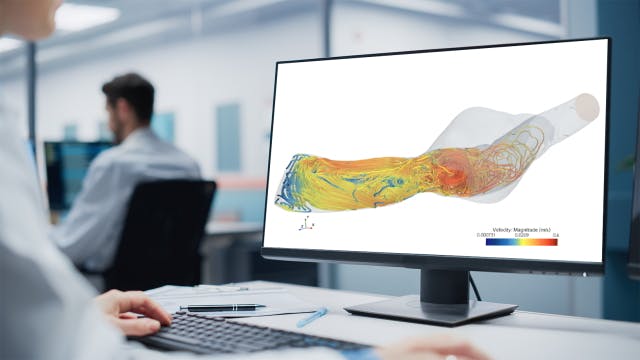In this webinar, we will discuss:
- The value of CFD for cardiovascular applications
- How CFD can be a critical element in thoracic stent graft in-silico trials
- The workflow for building a CFD model of a thoracic stent and evaluating its performance, including the use of AI/ML to develop methods for rapid assessment of stent effectiveness
- How CFD can be accelerated by scaling up on the cloud with Simcenter Cloud HPC
- The portfolio of Simcenter solutions for the design and development of medical devices
<h2>The risks of thoracic aortic aneurysms</h2><p>A thoracic aortic aneurysm (TAA) is a life-threatening health condition that can cause death if the aortic wall ruptures. TAA can be treated by the placement of a thoracic stent graft with the minimally invasive thoracic endovascular aortic repair (TEVAR) procedure. The primary function of the stent graft is to exclude the aneurysm so that the diseased aortic wall is protected from physiologic blood pressures thus preventing aneurysm growth and potential rupture. Aneurysm exclusion is achieved by having the stent graft form a “seal” above and below the aneurysm. Therefore, for successful TEVAR outcomes, preventing leakage (through lack of “seal”) around the stent graft is essential to stopping aneurysm growth and preventing rupture.</p><h2>CFD delivers essential insights on blood flow for stents</h2><p>Determining the leakage flow around the stent into the aneurysm is a direct and effective way to evaluate the hemodynamic performance of a deployed stent graft. Clinically, the measurement of these leakage flows is challenging, but computationally it is not. This highlights one of the most powerful aspects of simulation—the ability to quantify characteristics of interest in situations where it would be very difficult to do so in vivo, or even in bench tests. In the case of the stent flow, CFD (computational fluid dynamics) simulation can provide theessential insights.</p><h2>Know the result before placing a stent</h2><p>Thornton Tomasetti, a US-based scientific and engineering consulting firm, has created two CFD models to demonstrate how a stent graft can allow blood leakage to the aneurysm and how a well-deployed stent graft can seal the leakage. The fluid domains for these CFD models were extracted from previously completed finite element analyses (FEA) which virtually deployed stent grafts into virtual patient anatomies which are representatives of the diseased patient population.</p>
Meet the speakers

Zhu Zenghao
Project Engineer

Kristian Debus
Vice President & Silicon Valley Office Director

Mark Carlson
Portfolio Development Executive
